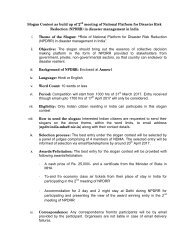National Disaster Management Guidelines School Safety Policy
School-Safety-Policy
School-Safety-Policy
Create successful ePaper yourself
Turn your PDF publications into a flip-book with our unique Google optimized e-Paper software.
SCHOOL <strong>Safety</strong><br />
POLICY <strong>Guidelines</strong><br />
Annexure – 8<br />
<strong>School</strong> DM Plan Model Template-<strong>National</strong> <strong>School</strong> <strong>Safety</strong> Programme (NSSP)<br />
Section 1 : Introduction:<br />
a. <strong>School</strong> profile (attached format in Annexure 8 (i)<br />
b. Aim and Objective of the plan<br />
c. Geographical location of the school.<br />
Guidance Note:<br />
●<br />
●<br />
This section of the plan will provide information relating to the school as per details given in<br />
Annexure-I It should also mention the objective of the plan, the stakeholders who will be using<br />
the plan and members who would be responsible for implementing, reviewing and updating the<br />
plan.<br />
This section can also include a map of the school.<br />
Section 2 : Hazard Risk and Vulnerability Assessment<br />
a. Non-structural assessment (can be done practically by all teachers and select students in a<br />
group exercise)<br />
b. Structural assessment (to be done by a Civil Engineer, Licensed Building Surveyor)<br />
c. Identification of hazards outside the school campus (Road <strong>Safety</strong>, Industrial Hazard, Chemical<br />
hazard, open drain flooding etc.)<br />
d. Database of past disasters/accidents which have affected the schools.<br />
e. Identification of vulnerable locations within the school campus<br />
f. Summary of the key findings and identifications of action for mitigation.<br />
Guidance Note:<br />
This section of the plan will focus on identifying the various vulnerable areas within the school building<br />
as well as the probable risks arising out of structural and non structural elements.<br />
Annexure<br />
For identifying non-structural and structural weakness in the school building a committee may be<br />
constituted comprising members of <strong>School</strong> Administration (Including Physical Education Teacher),<br />
officer from nearest fire station/Civil defence post warden, Health Service Provider (doctor/nurse/<br />
health worker) from nearest health centre/hospital/nursing home, officer from the nearest police<br />
station, engineers from PWD, SSA, Municipal Corporation. Zilla Parishad who may help in identifying<br />
the structural and non-structural weaknesses in the building. Likewise this committee can also identify<br />
hazard outside the school campus particularly the hazard related to road/traffic outside the school<br />
building, industrial (Chemical Hazard) which may be due to location of such an industry in vicinity of<br />
the school.<br />
This Hazard hunt activity will help in identifying some of the obvious risks like improper location of<br />
electricity panel in the school, open electricity panels, live wire if any, improper placing of cupboards<br />
and furniture, obstruction in the escape route or object that can fall during the Earthquake such as<br />
glass panel, flowerpot etc.<br />
This section of the plan can also document or provide details of any past disaster that had affected the<br />
school or in the vicinity of the school.<br />
45



